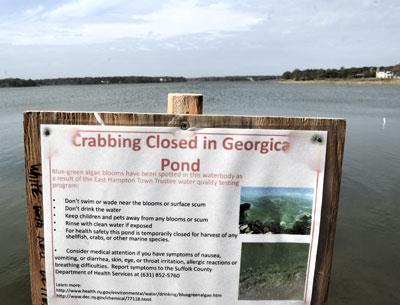Georgica Pond Remains Closed

Owing to a recent elevation of the cyanobacteria first detected in July, the East Hampton Town Trustees have closed Georgica Pond for another 21 days, through Nov. 4. Harvesting of crabs or other marine life will not be permitted during that time.
The concentration of the blue-green algae in the pond is among the highest measured on Long Island, said Stephanie Forsberg, the trustees’ assistant clerk. She suggested the “odd weather patterns we’ve seen this year” as a possible cause of the algal bloom’s resilience into autumn.
Cyanobacteria can be harmful to people and animals. While there is no data confirming that shellfish, such as crabs, or other marine species would be affected, or that consuming them would be unsafe, the trustees maintain that it is in the public’s best interest to avoid crabbing, swimming, or having any contact with the waters of the pond.
Christopher Gobler of Stony Brook University has installed monitoring equipment in the pond to supplement his regular water-quality sampling, Dr. Forsberg told her colleagues. The trustees expect it to provide important data that will help them lobby the State Department of Environmental Conservation for an expedited excavation permit. While the pond is typically opened to the ocean in the fall and spring, increased flushing would make for better water quality.
The trustees also considered creating a town wide shell-recycling project. Deborah Klughers distributed a written proposal to her colleagues that would “harness a natural resource that is largely lost to landfills.”
The project would reclaim scallop, clam, and oyster shells from fishermen, restaurants, residents, and businesses. Once dried, to dispose of bacteria and any remaining muscle, the shells would be used for coastal and marine habitat restoration.
Shells are mineral-rich and can be used in oyster-bed replanting, reef-building, and dune rebuilding and restoration, Ms. Klughers said. They are also a natural buffer against acidity, a growing problem affecting shellfish growth. A mound of oyster shells in suitable water with good tidal flow will be colonized by marine organisms, she said, providing substrate and habitat for other marine animals.
Restaurants and fish markets would benefit as well, by reducing the cost of waste disposal, she said. Trustee-owned land at the north side of the Atlantic Avenue parking lot could serve as a recycling area. “It is a lot of work, but I think it’s worthwhile.”
Noting that most seafood consumed in America is imported, Ms. Klughers proposed that a pilot program concentrate on scallops harvested from local waterways while the trustees seek a grant to implement the program on a larger scale.
A meeting between the trustees, baymen, and Ed Michels, chief of the East Hampton Town Marine Patrol, was tentatively scheduled for yesterday to discuss enforcement during the scallop season, which opens on Nov. 10. Last month, Nat Miller, a trustee and bayman, warned his colleagues that thieves might take as much as half of what is expected to be a healthy harvest. On Tuesday, Sean McCaffrey told his colleagues that he had already witnessed poaching. When confronted, he said, the poacher grew angry. “The guy took off.”
The town needs more money for more enforcement, Mr. McCaffrey said. “It’s a very important part of East Hampton.”
